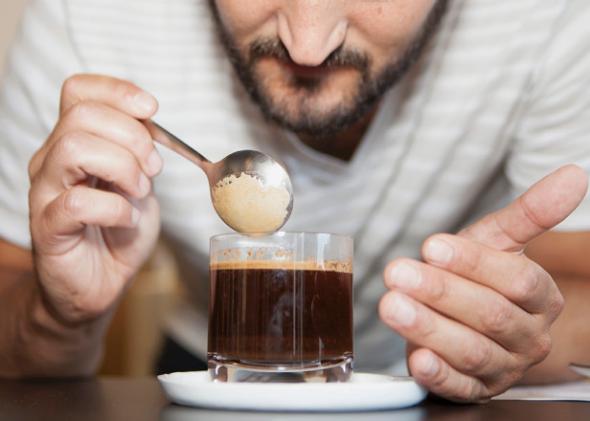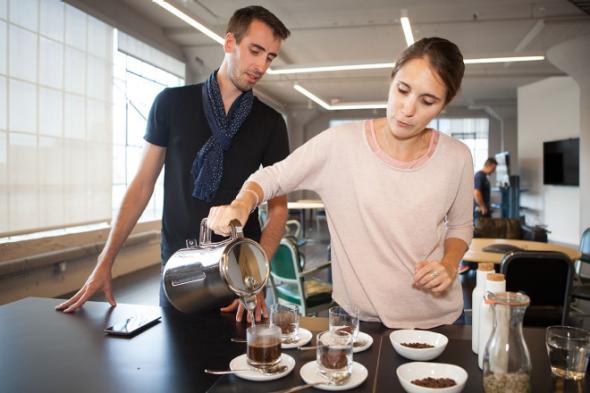These Scientists Want to Bring You Civet-Poop Coffee—but Without the Civets
Reprinted from 

Photo by Sonny Tumbelaka/AFP/Getty Images
Civet coffee is among the most expensive coffees in the world—a cup can cost $80. Coffee beans that have passed through the digestive tract of this cat-sized creature native to southeast Asia make a remarkably smooth brew, producers and aficionados say. But the cost isn’t just financial. Although civet coffee, also known by its Indonesian name, kopi luwak, originated with beans collected from the feces of wild animals, increased demand has encouraged producers to keep the animals in cages and force them to subsist on a nutritionally deficient diet of coffee beans.
“It’s the foie gras of coffee,” Camille Delebecque, a synthetic biologist, said during a recent visit to Wired. Delebecque saw a depressing civet farm on a trip to Indonesia a few years ago, and it got him thinking about alternatives.
After conducting a few DIY bio experiments in his kitchen, Delebecque decided to start a company. He teamed up with Sophie Deterre, a food scientist whose experience includes working on bitter orange aroma for Grand Marnier, to develop a fermentation process they say mimics some of the changes that occur in coffee beans as they wend through a civet’s digestive tract.
Their company is called Afineur, and they hope to have beans on sale by the end of the year. Delebecque says the price probably will be between $50 and $100 a pound—not cheap, to be sure, but considerably less than the hundreds people pay for a pound people of true kopi luwak.

Alex Washburn/Wired
The main effect of passing through the gut of a civet is to make the coffee less bitter and astringent, Delebecque says. It also changes the flavor profile in more subtle ways. Protease enzymes in the civet’s gut chop proteins into smaller bits, which in turn alters the aromas present after roasting.
Afineur’s fermentation process doesn’t recreate exactly what happens inside the civet, but is “inspired by it,” Delebecque says. Scientists haven’t yet characterized the microbiome of the civet gut in any detail, but it probably involves thousands of strains of bacteria, many of which would be difficult to cultivate in the lab. Delebecque declined to offer specifics about the microbes Afineur uses, but they probably comprise a much smaller but carefully chosen selection of bugs, some of which are easier-to-cultivate cousins of civet microbes. The fermentation takes two days, after which the beans are roasted.
Delebecque and Deterre were in San Francisco last week to present their work at a demo day for synthetic biology startup companies. (Other companies presented work on yeast that make cannabinoids and flowers that change color according to the time of day.) They also brought some beans by the office for a taste test.
Green and unroasted, the beans smelled of green beans and artichokes. Roasted and ground, the same beans had a nutty, toffee-like aroma. Grounds of the fermented coffee had a milder aroma that lacked a certain sharpness noticeable in the unfermented beans. (Afineur is still working out an agreement with a roaster to produce and distribute their coffee, so the version we tried won’t be the same as the commercial release.)
Slurping spoonfuls of coffee Deterre had carefully measured and brewed, the difference was obvious. The fermented beans were indeed less bitter and less astringent (the tongue-scraping quality of black tea that’s steeped too long). To my taste, they also were less acidic. The pH is actually about the same, Delebecque says (they checked), but the fermentation process changes the proportion of different acids, which can cause some people to perceive the fermented beans as less acidic.
Traditionally, coffee producers have had two ways to control the final product: choosing the beans, and determining the time and temperature of the roast. Fermentation adds a third possibility for creative control, Delebecque says. “We can explore other flavor landscapes in coffee,” Delebecque said. Whether those landscapes are worth the price will be up to coffee connoisseurs to decide.

Alex Washburn/Wired
More from Wired:
Future Tense is a partnership of Slate, New America, and Arizona State University.
